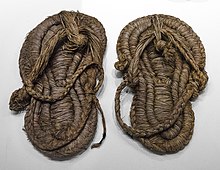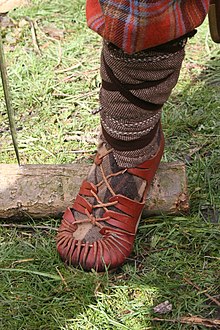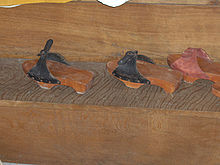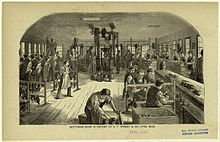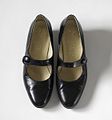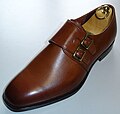Shoe
The shoes is a pedestrian clothing accessory made with the intention of providing protection and comfort to the foot, while it performs various activities. The set of all kinds of pedestrian accessories is called footwear.
Shoes, like the rest of the garments, are also designed for aesthetic and/or orthopedic purposes. Shoe design has varied enormously through time and from culture to culture, with appearance originally tied to function. Additionally, fashion has frequently dictated many design elements, such as heel height and heel fabric.
Contemporary footwear varies widely in style, complexity, and cost. A basic sandal may consist of a thin sole and simple lacing. Fashion shoes can be made of very expensive materials in complex constructions and sell for thousands of dollars a pair. Other shoes are for very specific purposes, such as those designed for mountain climbing or skiing.
History
The academic Joan Corominas in his Etymological Dictionary of the Spanish Language, supports the hypothesis that the word “shoe” may be an onomatopoeia, ¡tsap!, "the noise of the one who stomps, in Basque the word "zapaldú" that comes to say something like crushing, also "zaplada" as the step or stride is called. Now, the leather shoe is used much more than the sandal, especially in cold countries. At the same time, in the Middle Ages the shoe was made with flaps or alternating fabrics to protect the skin and reinforce the foot for a better fit, they were not very functional. In Europe, the shoe became a symbol of social status for the noble and rich but it reached ridiculous proportions, which forced its simplification and the creation of new styles until it reached the modern solid and sewn shoe. Since the 17th century, most leather shoes have been characterized by unique stitching. Advances in the rubber, plastic, synthetic fabric, and industrial adhesive industries have allowed manufacturers to create shoes that differ significantly from traditional manufacturing techniques. Therefore, leather, which had been the main material of making, is now generally used to make expensive shoes, while sports shoes do not use real leather.
Starting in the 20th century, shoes evolved rapidly and dizzyingly. The stylistic changes in both men and women made fashions and designs adapt to the different historical moments and thought of that century. Designers specialized in the design of footwear began to appear, keeping their brands and firms renowned. In the XXI century, the concept of ergonomics further revolutionized the development of high-tech shoes such as sneakers, the formal shoe and the light shoe for warm climates. This development came hand in hand with space technology where shoes appeared with different types of tractionable sole designs that were applied to high-end sports shoes.
Antiquity
America
The oldest known shoes are sagebrush bark sandals estimated to date back to 7000 or 8000 BC. C., found in the Fort Rock cave in the state of Oregon, United States in 1938. The oldest leather shoe in the world, made of a single piece of cowhide tied with a leather lace along the length of the shoe. the seams on the front and back, was found in the Areni-1 cave complex in Armenia in 2008 and is believed to date to 3500 BC. Dating to 3300 BC, Ötzi the Iceman's shoes had a brown bearskin base, deerskin side panels, and a net of bark cord, which was fitted around the foot. The Jotunheimen shoe was discovered in August 2006: archaeologists estimate that this leather shoe was made between 1800 and 1100 BC, making it the oldest item of clothing discovered in Scandinavia.
There were some fake shoes that were initially considered authentic, and it was said that they were the first that had reached our days in physical form; These are sandals that they claimed dated back to 8,000 B.C. They are made of vegetable fiber of 30 cm. of length. It was found in a cave in the state of Missouri, near Colorado, in the United States, they were analyzed by the anthropologist Michael J. O'Brian, who stated that these sandals were too sophisticated for their time, they had interwoven soles and a kind of rope to hold it. Also kept at the University of Oregon History Museum are sandals that they say date from around 10,000 to 13,000 years ago. Made of sage bark and other fibers, they were found in a cave in Rock Fort, Oregon, USA, but due to the type of intertwining of fibers and the general condition of the sandal, its dating to that date is impossible.
It is believed that the shoe may have been worn much earlier, but as the materials used were highly perishable, evidence of older footwear is difficult to find. By studying the bones of the smaller toes (as opposed to the big toe), it was observed that its thickness decreased approximately between 40,000 and 26,000 years ago. This led archaeologists to deduce that wearing shoes caused less bone growth, resulting in shorter, slender toes. These early designs were very simple, often merely 'foot bags'.; leather to protect them from rocks, debris and cold.
Many of the earliest Native Americans wore a similar type of shoe, known as a moccasin. It is a tight-fitting, soft-soled shoe, usually made of leather or bison skin. Many loafers were also decorated with various beads and other ornaments. Moccasins were not designed to be waterproof, and in humid weather and the hot summer months, most Native Americans went barefoot. The leaves of the sisal plant were used to make sandal cord in South America, while Native Americans Mexico used the cassava plant.
Africa and the Middle East
As civilizations began to develop, strappy sandals (the forerunners of modern flip-flops) were worn. This practice dates back to images of them on murals in ancient Egypt from 4000 B.C. "Thebet" may have been the term used to describe these sandals in Egyptian times, possibly from the city of Thebes. The first of these thebet were found in the Middle Kingdom, but it is possible that they debuted in the Early Dynastic Period. A pair found in Europe were made from sheets of papyrus and are estimated to be approximately 1,500 years old. They were also worn in Jerusalem during the 1st century CE. Thong sandals were worn by many civilizations and made from a wide variety of materials. Ancient Egyptian sandals were made from papyrus and palm leaves. The Masai of Africa made them from rawhide. In India they were made of wood.
Although strappy sandals were in common use, many people in ancient times, such as the Egyptians, Hindus, and Greeks, saw little need for footwear, and more often than not, preferred to be barefoot. The Egyptians and Hindus made some use of ornamental footwear, such as a soleless sandal known as 'Cleopatra', which provided no practical protection for the foot.
Asia and Europe
The ancient Greeks viewed footwear as self-indulgent, unsightly, and unnecessary. Shoes were worn primarily in the theater, as a means of increasing height, and many preferred to go barefoot. Athletes in the Ancient Olympic Games participated barefoot—and nude. Even the gods and heroes were depicted mainly barefoot, as were the hoplite warriors. They fought barefoot battles and Alexander the Great conquered his vast empire with barefoot armies. Runners in Ancient Greece were also believed to have run barefoot.
The Romans, who eventually conquered the Greeks and adopted many aspects of their culture, did not adopt the Greek perception of footwear and clothing. Clothing in ancient Rome was considered a sign of power, and footwear was considered a necessity for living in a civilized world, although slaves and the destitute often went barefoot. Roman soldiers were issued a chiral footwear (shoe different left and right). Shoes for soldiers had riveted insoles to extend the life of the leather, increase comfort, and provide better traction. The design of these shoes also designated the rank of the officers. The more intricate the insignia and the higher the boot reached on the leg, the higher the rank of the soldier. There are references to the wearing of shoes in the Bible. In China and Japan rice straw was used to make them.
Starting around 4 BC, the Greeks began wearing symbolic footwear. These were highly decorated to clearly indicate the status of the wearer. Courtesans wore leather shoes dyed white, green, lemon, or yellow, and young betrotheds or newlyweds wore pure white shoes. Due to the cost of lightening the leather, shoes of a paler shade were a symbol of wealth in the upper class. Often the soles were carved with a message so that it would be imprinted on the ground. Shoemakers became a notable profession at this time, and Greek shoemakers became famous in the Roman Empire.
Middle Ages and early modern times
Asia and Europe
A common casual shoe in the Pyrenees during the Middle Ages was the espadrille. This is a sandal with a braided jute sole and fabric upper, often featuring fabric laces that are tied around the ankle. The term is French and comes from esparto. The shoe originated in the Catalonia region of Spain as early as the 13th century, and was commonly worn by peasants in the area's farming communities.
During the Song dynasty in China, new styles began to be developed, one of them being the debut of foot straps. They were first used by the Han noble classes, but soon spread to the entire society. Women used these shoes to develop their 'lotus feet', which attracted men. The practice supposedly began during the Shang dynasty, but became popular around AD 960.
When the Mongols conquered China, they dissolved the practice in 1279, and the Manchus outlawed it in 1644. The Han people, however, continued to use the style without much government intervention.
In medieval times, shoes could be up to 2 feet long, and their toes were sometimes filled with fur, wool, moss, or grass. Many medieval shoes were made using the turnshoe method of construction, in which the upper part was turned flesh side out, and was glued to the sole and attached to the edge by a seam. The shoe was then turned inside out so that the flower was left out. Some shoes were developed with toggle flaps or laces to tighten the leather around the foot for a better fit. Surviving medieval shoes often fit the foot perfectly, with the right and left shoe being mirror images. By 1500, the turning shoe method was largely superseded by the welt-sole method (in which the upper is sewn to a much stiffer sole and the shoe cannot be turned inside out.) The turned shoe method is still used for some dance shoes and specialty shoes.
In the 15th century, pattens became popular for both men and women in Europe. They are commonly considered the ancestor of the modern high-heeled shoe, while the poor and lower classes of Europe, as well as slaves in the New World, went barefoot. By the 15th century, Krakóvians were fashionable in Europe. This style of shoe gets its name because it is believed to have originated in Krakow, the capital of Poland. The style is characterized by the toe of the shoe, known as a 'polaine', which often rested on a whalebone attached to the knee to keep the toe from getting in the way when walking. Also during the 15th century, chopines were created in Turkey, and they were usually about 17 to 20 cm tall. These shoes became popular in Venice and throughout Europe as a status symbol that revealed wealth and social position. During the 16th century, royalty, such as Catherine de' Medici or Mary I of England, began wearing high-heeled shoes to appear taller or larger than life. By 1580, even men wore them, and a person of authority or wealth was often referred to as, 'well shod'. In 17th century France, heels were worn exclusively by aristocrats. Louis XIV of France forbade the wearing of red high heels, except for himself and his royal court.
Over time, the modern shoe was devised, with a sewn sole. Since the 17th century, most leather shoes have used a stitched sole. It remains the standard for higher quality dress shoes today. Until around 1800, sewn-soled shoes were usually made without differentiating between the left and right foot. Today these shoes are referred to as 'straight'. Only gradually did modern foot-specific footwear become standard.
Industrial Age
Asia and Europe
Shoemaking became more commercial in the mid-18th century as it expanded as a cottage industry. Department stores began to stock footwear, made by many small manufacturers in the area.
Until the 19th century, shoemaking was a traditional craft activity, but by the end of the century the process had been almost completely mechanized and production took place in large factories. Despite the obvious economic benefits of mass production, the factory system produced shoes without the individual differentiation that the traditional shoemaker could provide.
It was in the 19th century that Chinese feminists called for an end to the use of foot straps and a ban was created in 1902. The ban was soon repealed until the new nationalist government banned it again in 1911. It was effective in coastal cities, but in rural cities it continued without much regulation. Mao Zedong imposed the norm in 1949 and it continues in force in contemporary times. Several people still have lotus feet today.
The first steps towards the mechanization of production were taken during the Napoleonic Wars by engineer Marc Brunel. He developed machinery for the mass production of boots for soldiers in the British Army. In 1812, he devised a plan to make spiked boot-making machinery that automatically attached the soles to the uppers using metal pins or nails. With the support of the Duke of York, shoes were made and, due to their strength, under cost and durability, were introduced for army use. That same year, the use of screws and staples was patented by Richard Woodman. Brunel's system was described by Sir Richard Phillips as a visitor to his factory in Battersea as follows:
In another building they showed me their shoe factory, which, like the other, is filled with ingenuity, and, as far as the subdivision of the work, puts this task at the same level as the admired pin factory. Each step is affected by the most elegant and precise machinery; while, as each operation is performed by one hand, each shoe passes by twenty-five hands, which complete from the skin, supplied by the tanner, one hundred pairs of strong shoes and well finished a day. All details are made by the ingenious application of mechanical faculties, and all parts are characterized by their accuracy, uniformity and accuracy. As every man takes a single step in the process, which does not imply any knowledge of what those who precede or follow him do, the employed persons are not shoemakers, but wounded soldiers, able to learn their respective tasks in a few hours. The contract for these shoes to be delivered to the Government is 6s. 6d. by pair, at least 2s. less than previously paid for an uneven and cobbled article.
However, when the war ended in 1815, manual labor became much cheaper and the demand for military equipment diminished. As a consequence, Brunel's system became unprofitable and soon went out of business.
America
Similar demands around the time of the Crimean War stimulated a renewed interest in mechanization and mass production methods, which proved more durable. A Leicester shoemaker, Tomas Crick, patented a design for a riveting machine in 1853. His machine used an iron plate to drive iron rivets into the sole. The process greatly increased the speed and efficiency of production. He also introduced the use of steam rolling machines to toughen leather and cutting machines in the mid-1850s.
The sewing machine was introduced in 1846 and provided an alternative method for the mechanization of shoemaking. By the late 1850s, the industry was beginning to shift toward the modern factory, primarily in the United States and parts of England. In 1856, American Lyman Blake invented a shoe-sewing machine, which he perfected in 1864. Partnering with McKay, his device became known as the McKay sewing machine and was quickly adopted by manufacturers throughout New England. Bottlenecks were opened in the production chain due to these innovations, manufacturing phases, such as nailing and finishing, were increasingly automated. By the 1890s, the mechanization process was largely complete.
On January 24, 1899, Humphrey O'Sullivan of Lowell, Massachusetts, obtained a patent for a rubber heel for boots and shoes.
Globalization
In 1910, a process was developed to manufacture shoes without seams, that is, glued. Since the mid-20th century, advances in rubber, plastics, synthetic fabrics, and industrial adhesives have allowed manufacturers to create shoes that depart considerably from traditional craft techniques. Leather, which had been the main material in previous styles, has continued to be common in expensive dress shoes, but athletic shoes often have little or no real leather. The soles, which were previously sewn by hand, are now sewn by machine or simply glued on. Many of these new materials, such as rubber and plastic, have made footwear less biodegradable. It is estimated that most mass-produced shoes take 1,000 years to degrade in a landfill. In the late 2000s, some shoe manufacturers took action and began producing shoes made entirely of degradable materials, such as the Nike Considered.
In 2007, the global footwear industry had a global market of $107.4 billion in terms of revenue, and it is expected to grow to $122.9 billion by the end of 2012. Footwear manufacturers in the People's Republic of China represent 63% of production, 40.5% of world exports and 55% of the sector's income. However, many manufacturers in Europe dominate the higher price and value-added end of the market.
Culture and folklore
As an integral part of human culture and civilization, shoes have found their way into our culture, folklore, and art. A popular 18th century children's song is 'There was an old woman who lived in a shoe'. This story tells of an old woman who lives in a shoe with a bunch of kids. In 1948, Mahlon Haines, a shoe salesman from Hallam, Pennsylvania, built an actual house shaped like a work boot as a form of advertising. The Haines Shoe House was rented to newlyweds and the elderly until his death in 1962. Since then, it has served as an ice cream parlor, boarding house, and museum. It still stands and is a popular roadside attraction.
Shoes also play an important role in the fairy tales Cinderella and The Red Slippers. In the film adaptation of the children's book The Wonderful Wizard of Oz, a pair of ruby red slippers play a key role in the plot. The 1985 comedy The Man with a Red Shoe' features an eccentric man who wears one normal work shoe and one red one who becomes the center of the plot.
A poem, written by Phebus Etienne under the title "Shoes," focuses on them. Describes religious messages and consists of three stanzas. The first stanza is one verse long, while the second has 13 verses and the third 14 verses. Throughout the poem, the protagonist talks about his dead mother and her routine with her grave. Haitians are said to "don't put shoes on the dead," as it makes it easier for the spirits to "step on the offerings."
The sneaker collection has also existed as part of the urban subculture in the United States for several decades. In recent decades, this trend has spread to European nations such as the Czech Republic. A sneakerhead is a person who owns several pairs of sneakers as a form of collecting and fashion. One contributing factor to the growth of sneaker collecting is the continued worldwide popularity of the Air Jordan line of sneakers designed by Nike for basketball star Michael Jordan.
In the Old Testament of the Bible, the shoe is used to symbolize something worthless or of little value. In the New Testament, the act of taking off shoes symbolizes servitude. The ancient Semitic-speaking peoples regarded the act of removing one's shoes as a sign of reverence when approaching a holy person or place. In the Book of Exodus, Moses was instructed to remove his shoes before approaching the burning bush:
Take off your shoes from your feet, for the place where you are [is] holy land (KJV).
Removing a shoe also symbolizes the act of giving up a legal right. In Hebrew custom, if a man chose not to marry her brother's widow without her children, the widow would take her brother-in-law's shoe to symbolize that she had abandoned her duty. In Arab custom, removing the shoe also symbolized the dissolution of the marriage.
In Arab culture, showing the sole of a shoe is considered an insult, and throwing a shoe and hitting someone with it is considered an even greater insult. Shoes are considered dirty because they often touch the ground and are associated with the lowest part of the body: the foot. For this reason, they are prohibited in mosques and it is considered impolite to cross your legs and show the soles of your shoes during a conversation. This insult was demonstrated in Iraq, first when the statue of Saddam Hussein was torn down in 2003, Iraqis gathered around him and beat the statue with their shoes. In 2008, US President George W. Bush was told by a journalist threw a shoe as a statement against the Iraq war. More generally, shoe throwing or stomping, showing the sole of the shoe, or using shoes to insult are forms of protest in many parts of the world. Incidents in which shoes were thrown at political figures have occurred in Australia, India, Ireland, Taiwan, Hong Kong, Pakistan, the United Kingdom, the United States, and most notably in the Arab world.
Empty shoes can also symbolize death. In Greek culture, empty shoes are the equivalent of the American funeral wreath. For example, empty shoes placed outside a Greek house indicate to others that the family's son has been killed in combat. At an event commemorating the 10th anniversary of the 9/11 attacks, 3,000 pairs of empty shoes were used to recognize the deceased. The Shoes on the Danube Bank is a memorial in Budapest, Hungary. Conceived by film director Can Togay, he created it on the eastern bank of the Danube River with sculptor Gyula Pauer to honor the Jews who were killed by fascist Arrow Cross militiamen in Budapest during World War II. They were ordered to remove their shoes and shot at the water's edge so that their bodies would fall into the river and be washed away. The memorial monument represents the shoes that were left on the shore.
Types of shoes
Currently the shoes are prepared for each physical conditioning of the terrain. The sandal is a kind of shoe that serves to get more fresh air on the foot, the shoe allows more capacity for movement and the boot allows passage over liquids in a waterproof manner.
The material of the shoes lies through the genre, but complicated methods such as wooden and metal shoes have also been seen.
The types of shoes of different genders are not only extended to the need, but also to the popular and artistic design. In the case of a Punk Shoe, it acquires the rebellious design, which is useful to personify the image.
Lately, the so-called height shoes (or elevator shoes ) for men have emerged, which have an internal enhancement that is not noticeable to the naked eye and that allows growth up to 7 cm tall. This system makes it possible to overcome a certain inequality that existed with women when it came to wanting to be taller and to correct dysmetria problems in the lower body.
Although sandals were the most common footwear in ancient times, other types were also used. The first known shoe is a leather model in the form of a moccasin. It was fastened to the foot with rawhide laces and was used mainly in Babylon around 1600 BC. c.
From 500 B.C. C., upper-class Greek women adopted similar, tight-fitting leather footwear. The Romans were the first to establish, around 200 B.C. C., shoemaker guilds.
In the Middle East, cleats were added to shoes to lift the foot off the hot desert sand. In Europe from the XVI to the {{siglo|XVII çç century, the heels of shoes were always painted red.
The wealthy classes of Europe in the 17th century wore sky-high heels. So tall were they that two servants were needed, one on each side of the lady to help them put them on.
In the 19th century in Philadelphia, the first pair of shoes was made in which the right shoe was different from the left. Until then all the pairs of shoes in the world were the same.
Sneakers were invented in the United States of America in 1916. They caught on quickly because they were comfortable for running, jumping, or walking, but they were originally worn for field work.
In the middle of the XX century, safety shoes emerged in the labor market, which is a booty that is normally medium upper, thick walls, robust high-traction sole and consists of a metal protection for the toes.
Basic parts of a shoe
A shoe or footwear consists of the following parts:
- Heel or heel: Usually wooden piece on which the heel is supported, confers a certain height and maintains the muscles of the calf.
- sole: It is the lower surface on which the pedestre traction is performed.
- Entresuela: These are the structural inner layers that bind the sole with the rest of the footwear.
- Arc or Boveda: It is an ant that helps to maintain the planted arch of the foot supported.
- Punta: It is the front section of the shoe.
- lining: They are the cover of the shoe, leather or textile material that shape the shoe.
- Pala: It is a piece that covers the empeine on the outside of the shoe and joins with the lining.
- Template: It is the horma of the shoes and is the inner surface where the foot is supported.
- Lengüeta: It is an internal tab that allows the opening of the shoes and covers the empeine once closed.
- Necklace: It is the neck or edge of the shoe that goes in contact with the ankle.
- Caña: It is the extension structure that covers from the ankle to the knee.
- Camellón o cambrillón: It is a plastic, flat metal piece that is located between the sole and intersole and serves to maintain the resilience of the footwear.
- Counter-force: It is the outer protection of the heel and allows the lifting of the foot by the foot.
- Amarres: It is the way the footwear is held as a whole by means of cords, buckles, closures etc.
Contenido relacionado
13th century
Sabadell
Burgos Province


